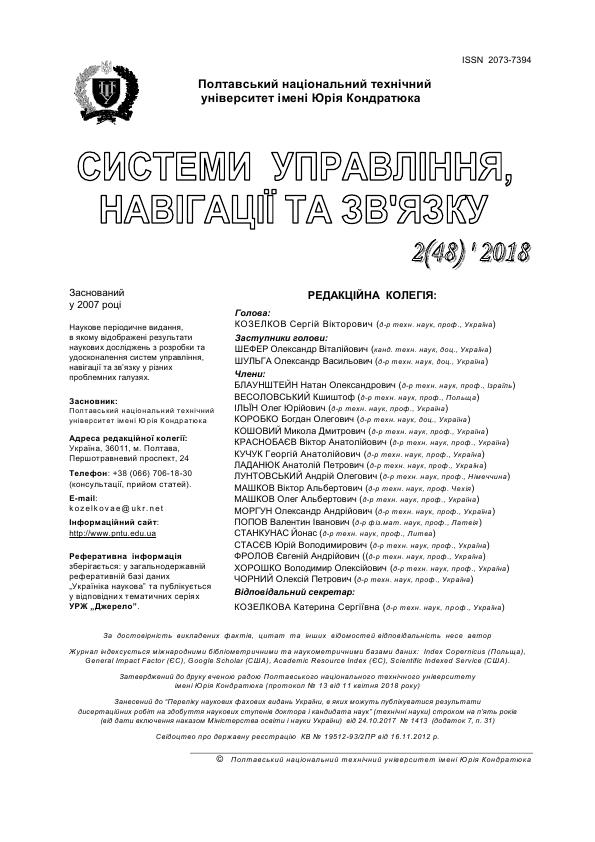STUDY OF EFFICIENCY OF APPLICATION OF DIFFERENT ANTENNAS FOR THE RECEIVING OF SPECIAL INFORMATION FROM THE SATELLITES TYPE OF CUBESAT FOR REMOTE SENSING OF THE EARTH
DOI:
https://doi.org/10.26906/SUNZ.2018.2.154Keywords:
spacecraft, CUBESAT, remote sensing of the Earth, onboard transmitter, receiving station, minimum angles of the information receiving areaAbstract
The subject matter of the article is the radio links of the target information of the space remote sensing systems (Earth remote sensing) from spacecraft of the CUBESAT type. The aim is to study the effectiveness of receiving antennas of different diameters (5 and 12 m), namely, changing the information receiving zone. The goal: to develop a mathematical for determining the minimum reception angles of the target information, taking into account the directional pattern and the flaps of the maximum of the diagram from the direction to the receiving station. Determine the minimum angles of the receiving location of the target information with a given error probability per bit of information (< 10-7) under the condition of different types of on-board transmitting antennas and receive antennas of different diameters. The methods used are: synthesis, mathematical modeling and graphical analysis of the results obtained. The following results are obtained. When using a transmitting helical antenna, the minimum reception angles with a given error probability per bit of information < 10-7 are less by 100 than using a patch antenna. But the value of signal to noise ratio (S/N) when using a helical antenna is dominated by a patch antenna at elevation angles greater than 640, subject to rotation in the direction of the receiving station. When using reflectors with a diameter of 5 m, it is possible to receive information with a specified error probability only for elevation angles greater than 23.50. Thus, the use of reflectors with a diameter of 12 m will significantly increase the possibilities for surveying the Earth's surface due to a longer session of receiving special information. Conclusions. Analysis of the technical characteristics of modern on-board components of spacecraft like CUBESAT has demonstrated the promise of using such spacecraft for environmental monitoring. The study of the CUBESAT satellite radio link was carried out taking into account the directional pattern of the on-board transmitting antenna of the target radio link, using a mathematical model created by the author. Using a patch antenna in comparison with a helix antenna makes it possible to extend the information receiving area with specified quality indicators by 100 by the elevation angle. Comparison of receiving stations with an antenna diameter of 5 and 12 m indicates the prospects of using reflectors of antenna systems with a diameter of 12 m, which are in Ukraine. The use of ground antennas with a reflector diameter of 12 m will allow receiving special information at minimum elevation angles of 120 under the conditions of the calculations (orbit height, on-board transmitter power, data transfer speed).Downloads
References
Small spacecraft technology. State of the art. Mission design division staff Ames research center, Moffett Field. California: July 2014.
TM space data link protocol. Recommendation for space data system standards. CCSDS. 130.1-G-2. Green book. Washington, D.C.: CCSDS, November 2012.
Cubesat communications system table. Mode of access: World Wide Web https://www.klofas.com/comm-table/
Digital Video Broadcasting (DVB); Second generation framing structure, channel coding and modulation systems for Broadcasting, Interactive Services, News Gathering and other broadband satellite applications (DVB-S2), ETSI EN 302 307 V1.2.1: European Telecommunications Standards Institute, Mart 2009.
Louis J. Satellite Communications Systems Engineering Atmospheric Effects, Satellite Link Design and System Performance / Louis J. Ippolito Jr. California: A JOHN WILEY & SONS, INC., 2008. – 396 p.
Planet Labs Specifications: Spacecraft Operations & Ground Systems. Mode of access: World Wide Webhttp: //www.rsgis.ait.ac.th/main/wpcontent/uploads/Planet-Labs- Spacecraft-Ops.pdf/
Ziemer, Rodger E. Principles of communication : systems, modulation, and noise / Rodger E. Ziemer, William H. Tranter. − Seventh edition, California: A JOHN WILEY & SONS, INC., 2014. – 746 p.
Nguyen H. A first course in digital communication. / Nguyen H., Shwedik // UK Cambridge university press – 2009. 564 p.
Roddy. D. Satellite communication. Fourth edition. / Roddy D. // New York: McGraw-Hill – 2006. 656 p.




